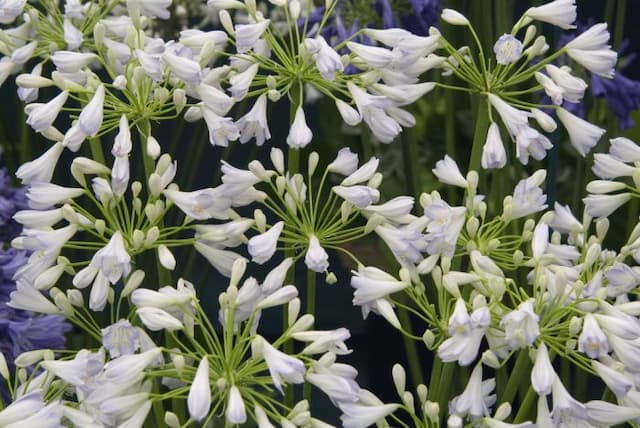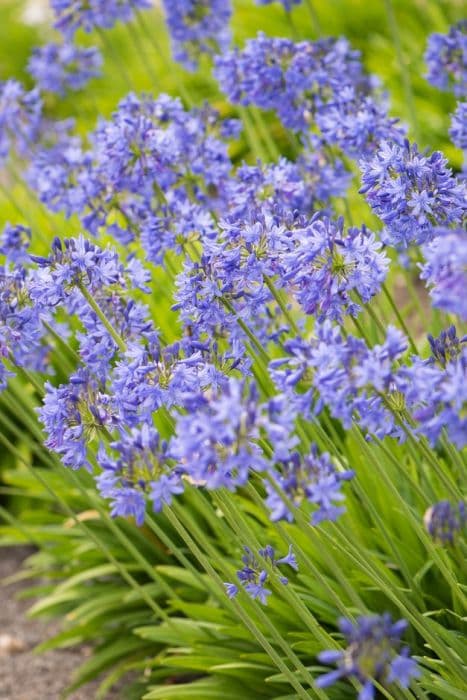African Lily Agapanthus Fireworks = 'Mdb001'
![African lily [Fireworks]](/_next/image?url=https%3A%2F%2Fplants-admin.emdemapps.com%2Fimages%2Fplants%2F%2Fimages%2F604b586d735bf.png&w=3840&q=75)
ABOUT
The Agapanthus Fireworks, commonly known as the African Lily Fireworks, is a striking plant with a vibrant and showy appearance. Its most noticeable feature is the breathtaking bloom clusters that it produces. These flowers are aptly named 'Fireworks' for their brilliant and explosive array of colors. Each bloom is composed of trumpet-shaped flowers with a blend of two tones, typically displaying a rich blue at the base, which transitions to a white or lighter blue at the tips, creating a bi-color effect that is reminiscent of a festive firework display. The flowers are perched atop long, sturdy stalks that arise from a lush base of foliage. The leaves themselves are strappy and arching, forming a dense clump with a deep green color that serves as a beautiful contrast to the dramatic blossoms above. This lush foliage provides a handsome backdrop throughout the growing season, even when the plant is not in bloom. Overall, the African Lily Fireworks is recognized for its striking flowers that draw attention with their distinctive coloration and arrangement. The combination of the fireworks-like flower heads and the rich green foliage makes this plant a popular choice in gardens for creating a focal point or for adding a splash of color during its blooming season.
About this plant
 Names
NamesFamily
Amaryllidaceae
Synonyms
African Lily, Lily of the Nile, Love Flower
Common names
Agapanthus Fireworks = 'Mdb001'.
 Toxicity
ToxicityTo humans
The Agapanthus, also known as the African Lily or Lily of the Nile, does contain toxic compounds, primarily in the form of saponins. If parts of the plant are ingested, humans may experience symptoms such as nausea, vomiting, and diarrhea. In some cases, skin contact with the sap can cause irritation or allergic reactions. While severe toxicity is rare, ingestion can potentially lead to more serious effects, particularly in children and pets.
To pets
For pets, the African Lily or Lily of the Nile is also toxic. Ingestion of the plant can lead to symptoms that include vomiting, diarrhea, and drooling. In more severe cases, ingestion may cause lethargy, abdominal pain, tremors, or even cardiac problems. It is especially important to keep the plant out of reach of pets, as they might not show symptoms immediately, and the consequences of ingestion can be potentially severe.
 Characteristics
CharacteristicsLife cycle
Perennials
Foliage type
Evergreen
Color of leaves
Green
Flower color
Mixed
Height
2-3 feet (0.6-0.9 meters)
Spread
2-3 feet (0.6-0.9 meters)
Plant type
Bulb
Hardiness zones
8
Native area
South Africa
Benefits
 General Benefits
General Benefits- Attractive Flowers: Features showy clusters of blue and white bicolor flowers that are appealing in any landscape.
- Long Blooming Period: Blooms for an extended period during the summer months, providing lasting color.
- Drought Tolerant: Once established, Agapanthus Fireworks is relatively drought-tolerant, making it suitable for water-efficient gardens.
- Low Maintenance: Requires minimal care once established, with occasional watering and fertilizing.
- Pest Resistant: Resists many common pests, reducing the need for chemical treatments.
- Deer Resistant: Typically not favored by deer, which can minimize damage to the garden.
- Attracts Pollinators: Draws in bees, butterflies, and other beneficial pollinators, supporting biodiversity.
- Container Friendly: Can be grown in pots, making it a versatile option for patios, balconies, and other small spaces.
- Dramatic Foliage: Offers striking green foliage that provides a lush backdrop to its vivid flowers.
- Landscape Design: Ideal for adding vertical interest to borders, beds, and containers with its tall flower stalks.
 Medical Properties
Medical PropertiesThis plant is not used for medical purposes.
 Air-purifying Qualities
Air-purifying QualitiesThis plant is not specifically known for air purifying qualities.
 Other Uses
Other Uses- Photography Prop: Agapanthus, with its striking blooms, offers a vibrant backdrop or focal point for photographers specializing in garden and plant photography.
- Educational Tool: Botany educators can use Agapanthus as a practical example to teach students about monocotyledonous plant structures and flower development.
- Fabric Dye: The deep blue or violet flowers of the Agapanthus could potentially be used to create natural dyes for coloring fabrics.
- Aromatherapy Enhancement: The subtly fragrant flowers may be used in creating a calming atmosphere when dried and added to potpourri mixtures or scent sachets.
- Garden Borders: Because of their clumping nature, Agapanthus can be used to create delineated borders in garden design, providing structure and color.
- Artistic Inspiration: The unique form and color of Agapanthus flowers can serve as artistic inspiration for painters, illustrators, and other visual artists.
- Feng Shui: Said to bring good luck and prosperity, Agapanthus can be used in the garden to enhance the Feng Shui layout of a space.
- Event Decoration: The tall, elegant flower stalks can be used in large floral arrangements or as centerpieces for weddings and other events.
- Culinary Garnish: The non-toxic flowers can provide an exotic and decorative garnish to upscale culinary dishes, though they are not commonly consumed.
- Pollinator Attraction: While not an unusual use, planting Agapanthus can support local ecosystems by attracting bees, butterflies, and other pollinators.
Interesting Facts
 Feng Shui
Feng ShuiThe African Lily, commonly known as Agapanthus, is not traditionally associated with Feng Shui practice.
 Zodiac Sign Compitability
Zodiac Sign CompitabilityThe African Lily is not used in astrology practice.
 Plant Symbolism
Plant Symbolism- Love Letters - The name "Agapanthus" is derived from the Greek words "agape," meaning love, and "anthos," meaning flower, which often suggests the plant symbolizes a message of love.
- Beauty - With its striking blue and white flowers that resemble fireworks, Agapanthus Fireworks often represents beauty and uniqueness.
- Endurance and Perseverance - These plants are known for their hardiness and ability to thrive in difficult conditions, making them a symbol of enduring through hardships.
- Fertility and Fecundity - The lush, full blossoms and frequent seed production can represent fertility and abundance.
- New Beginnings - Agapanthus often blooms in the summer, when many people start new ventures or experiences, thus representing fresh starts or new journeys.
 Water
WaterAfrican Lily, commonly known as Agapanthus Fireworks, should be watered deeply once a week, ensuring that the soil is moist but not waterlogged. During the growing season, this could mean about 1 gallon per plant for every watering session, depending on the size of the plant and the environmental conditions. However, in the winter months when the plant is dormant, reduce watering to every two to three weeks, monitoring the soil moisture level to prevent it from drying out completely. Always water at the base of the plant to avoid wetting the foliage and blooms, which can lead to fungal diseases.
 Light
LightAfrican Lily thrives in full sun to partial shade. It should be placed in a location where it can receive at least six hours of direct sunlight per day. Morning sun with afternoon shade is ideal, especially in regions with very hot summers, to prevent the foliage from scorching.
 Temperature
TemperatureThe African Lily prefers a moderate climate and can survive in temperatures ranging from 50 to 90 degrees Fahrenheit. Ideally, maintain a temperature between 60 and 75 degrees Fahrenheit for optimal growth. It can tolerate slight dips below 50 degrees Fahrenheit but should be protected from frost.
 Pruning
PruningPrune African Lily in late fall or early spring to remove spent flower stalks and any damaged or dead foliage. This encourages the plant to produce more blooms and maintain a tidy appearance. Pruning once a year is typically sufficient.
 Cleaning
CleaningAs needed
 Soil
SoilLily of the Nile (Agapanthus) prefers well-draining, fertile soil with a pH ranging from 6.0 to 8.0. A mixture of loamy soil, with added compost and a small amount of coarse sand or perlite, can provide the desired structure and nutrients. Amending the soil with organic matter will help enhance its fertility and ensure the best growth for Agapanthus Fireworks.
 Repotting
RepottingLily of the Nile should be repotted every 3 to 4 years, or when it becomes root-bound. Spring is the best time to do this, as the plant is coming into a period of active growth and will recover more quickly from any root disturbance.
 Humidity & Misting
Humidity & MistingLily of the Nile prefers moderate humidity levels, although it is fairly adaptable to different humidity conditions. Aim for around 40-60% relative humidity for optimal growth for Agapanthus Fireworks, but normal room humidity is usually sufficient.
 Suitable locations
Suitable locationsIndoor
Place in bright, indirect light and ensure pot has draining holes.
Outdoor
Plant in sun to partial shade with protection from strong winds.
Hardiness zone
8-11 USDA
 Life cycle
Life cycleThe Agapanthus Fireworks, commonly known as African Lily 'Fireworks', begins its life cycle when a seed germinates in moist, well-drained soil during spring. As it emerges, the seedling develops long, strappy leaves and establishes a strong, fleshy root system. In the following years, it grows into a clump-forming perennial with increased leaf production and development of a robust underground rhizome. After reaching maturity, typically within two to three years, the plant produces tall, erect stems that bear globular clusters of blue and white bicolored trumpet-shaped flowers during the summer months. Following pollination, usually by insects, the flowers give way to capsule-like seed pods that release seeds to start a new generation. During the winter, in colder climates, the plant may die back to the ground, only to resurge from its rhizome in the spring.
 Propogation
PropogationPropogation time
Spring-Early Summer
The most popular method of propagation for Agapanthus, commonly known as Lily of the Nile, is through division. The best time to divide Agapanthus is in the spring after the last frost when the plant has outgrown its current space or when you want to propagate new plants. To propagate by division, carefully dig up the clumps of Agapanthus with a shovel, ensuring that you maintain a healthy portion of roots with each section. Gently separate the clumps into smaller sections, each with at least one growing point or fan of leaves. After dividing, replant the sections at the same depth they were growing before, in well-draining soil and water thoroughly. Each division should be spaced about 12 to 18 inches (approximately 30 to 45 centimeters) apart to allow room for growth.









